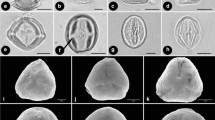Abstract
The pollen grain surface morphology of two Red Delicious apple (Malus × domestica Borkh.) sports, Aversang and Ultrared, and two Gala apple sports, Galalea and Splenola, were examined using scanning electron microscopy for genotype differentiation. Quantitative data on pollen dimensions, ridge patterns, and pore dimensions were extracted from micrographs using image analysis. Data were examined with analysis of variance, canonical variate analysis, and discriminant analysis in order to differentiate genotypes. The combination of image analysis to extract quantitative data and multivariate analysis was successful in differentiating apple sports with exine pore and pollen grain measurements.
Similar content being viewed by others
References
Bailey, D.G., 1993. Frequency domain self filtering for pattern detection. Image and Vision Computing 93: 237–243.
Bracewell, R.N., 1989. The Fourier Transform. Scientific American, June: 62–69.
Crescimmano, F.G., F.A. de Pasquale, M.A. Germana, F. Ciampolini, & M. Cresti, 1988. Ultrastructural and physiological observations on the pollen of six lemon cultivars (C. limon (L.) Burm. f.). Proceedings of the Sixth International Citrus Congress, Tel Aviv.: pp. 451–457. Balance publishers, Philadelphia.
Cruz-Castillo, J.G., S. Ganeshanandam, B.R. MacKay, G.S. Lawes, C.R.O. Lawoko, & D.J. Woolley, 1994. Canonical discriminant analysis in horticultural research. Journal of the American Society for Horticultural Science, 29(10): 1115–1119.
Currie, A.J., 1995. Differentiating apple sports by pollen ultrastructure. M. Hort. Sci. Thesis. Massey University, Palmerston North, New Zealand.
Fogle, H.W., 1977a. Identification of tree species by pollen ultrastructure. Journal of the American Society for Horticultural Science, 102(5): 548–551.
Fogle, H.W., 1977b. Identification of clones within four tree fruit species by pollen exine patterns. Journal of the American Society for Horticultural Science, 102(5): 552–560.
Fujita, H., & C. Uchikawa, 1986. Electron microscopical study of mulberry with special reference to the identification of cultivars, pp. 25–29. In: K. Kitaura, T. Akihama, H. Kukimura, K. Nakajima, M. Horie and I. Kozaki (Eds.), Development of new technology for identification and classification of tree crops and ornamentals. Ministry of Agriculture, Forestry and Fisheries, Japan.
Galletta, G.J. 1983. Pollen and seed management, pp. 23–47. In: J.N. Moore & J. Janick (Eds.), Methods in Fruit Breeding, 1st edn., vol. 1. Purdue University Press, West Lafayette, Indiana.
Hebda, R.J., & C.C. Chinnappa, 1990. Studies on pollen morphology of Rosaceae in Canada. Review of Palaeobotany and Palynology, 64: 103–108.
Kozaki, I., & M. Hirai, 1986. Pollen ultrastructure of citrus for taxonomic identification, pp. 11–17. In: K. Kitaura, T. Akihama, H. Kukimura, K. Nakajima, M. Horie & I. Kozaki (Eds.), Development of new technology for identification and classification of tree crops and ornamentals. Minstry of Agriculture, Forestry and Fisheries, Japan.
Maas, J.L., 1977. Pollen ultrastructure of strawberry and other smallfruit crops. Journal of the American Society for Horticultural Science, 102(5): 560–571.
Marcucci, M.C., S. Sansavini, F. Ciampolini, & M. Cresti, 1984. Distinguishing apple clones and cultivars by surface morphology and pollen physiology. Journal of the American Society for Horticultural Science, 109(1): 10–19.
Marquard, R.D., & C.R. Chan, 1995. Identifying crabapple cultivars by isozymes. Journal of the American Society for Horticultural Science, 120(5): 706–709.
Martens, J., & T.A. Fretz, 1980. Identification of eight crabapples by pollen surface sculpture. Journal of the American Society for Horticultural Science, 105(2): 257–263.
Matsumoto, S., N. Hoshi, T. Tsuchiya, J. Soejima, S. Komori, & S. Ejiri, 1995. Acta Horticulturae, 392: 265–274.
Matsuta, N., M. Omura, & T. Akihama, 1982. Difference in micromorphological pattern on pollen surface of Japanese Pear cultivars. Japanese Journal of Breeding, 32: 123–128.
Matsuta, N., M. Omura, & T. Akihama, 1986. Identification and classification of Japanese pear cultivars by numerical approach of pollen morphology, pp. 1–10. In: K. Kitaura, T. Akihama, H. Kukimura, K. Nakajima, M. Horie & I. Kozaki (Eds.), Development of new technology for identification and classification of tree crops and ornamentals. Ministry of Agriculture, Forestry and Fisheries, Japan.
Menendez, R.A., F.E. Larsen, & R.J. Fritts, 1986. Identification of apple rootstock cultivars by isozyme analysis. Journal of the American Society for Horticultural Science, 111(6): 933–937.
Mulas, M., G. D'hallewin, & G. Nieddu, 1988. Pollen ultrastructure of twenty almond cultivars. Advances in Horticultural Science, 2: 88–95.
Mulcahy, D.L., M. Cresti, S. Sansavini, G.C. Douglas, H.F. Linskens, G.B. Mulcahy, R. Vignani, & M. Pancaldi, 1993. The use of random amplified polymorphic DNAs to fingerprint apple genotypes. Scientia Horticulturae, 54: 89–96.
Nybom, H., 1990. DNA fingerprints in sports of ‘Red Delicious’ apples. Hort Science, 12: 1641–1642.
Sharon, D., A. Adato, S. Mhameed, U. Lavi, J. Hillel, M. Gomolka, C. Epplen, & J.T. Epplen, 1995. DNA fingerprints in plants using simple-sequence repeat and minisatellite probes. Hort Science, 30(1): 109–112.
Tancred, S.J., A.G. Zeppa, & G.C. Graham, 1994. The use of PCR-RAPD technique in improving the plant variety rights description of a new Queensland apple (Malus domestica) cultivar. Australian Journal of Experimental Agriculture, 34: 665–667.
Thomas, D.R., 1992. Interpreting Discriminant Functions: A Data Analytic Approach. Multivariate Behavioral Research, 27(3): 335–362.
Ueda, Y., & Y. Okada, 1994. Discrimination of rose cultivar groups by pollen surface structure. The Journal of Horticultural Science, 69: 601–607.
Vezey, E.L., & J.J. Skvarla. 1990. Computerised feature analysis of exine sculpture patterns. Review of Palaeobotany and Palynology, 64: 187–196.
Weeden, N.F., & R.C. Lamb, 1985. Identification of apple cultivars by isozyme phenotypes. Journal of the American Society for Horticultural Science, 110(4): 509–515.
Whitmore, F.W., 1992. Plant variety rights testing systems in New Zealand. Plant Varieties and Seeds, 5: 151–162.
Author information
Authors and Affiliations
Rights and permissions
About this article
Cite this article
Currie, A., Noiton, D., Lawes, G. et al. Preliminary results of differentiating apple sports by pollen ultrastructure. Euphytica 98, 155–161 (1997). https://doi.org/10.1023/A:1003174529263
Issue Date:
DOI: https://doi.org/10.1023/A:1003174529263




